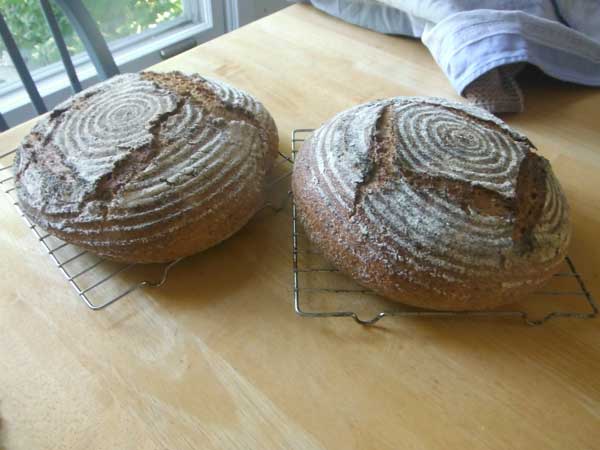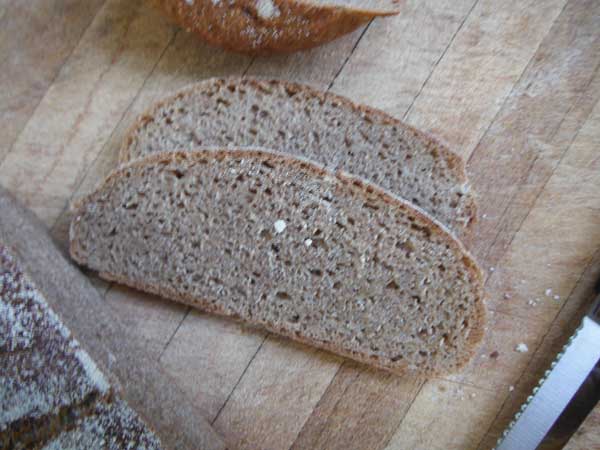Fast Day Breads
Today was the first day that I baked bread while I was fasting (I've blogged about fasting recently here). Baking bread while fasting really didn't give me all that much trouble. Nobody wants to use the generally debunked boiling frog metaphor anymore. But hey. The smell of baking bread is a little like that. Since I was at home during the actual baking, I wasn't really cognizant of it, it didn't cause me to become any hungrier; but my wife -- who was fasting too -- left for the post office while I had some loaves in the oven, and when she returned, she moaned, "make it stop!"
The same thing happened when I tried to play a cute YouTube video by MelodySheep, "Keep on Cooking" sung by Julia Child. "Everyone is singing about food!" she cried. "Make it stop!" I just wanted to turn on the captions, to sing along a few times (was it my voice, or Julia's, that started to drive her crazy?).
I guess the fasting is a bit harder on her than it is on me.
We did end up spending some quality time together that wasn't at the dining room table. My friend's sister had some grapes that she didn't want, coming ripe, and we picked them for her. In thanks, we offered her a dozen eggs, from our backyard chickens, but she didn't want them. Instead, she said she had tasted my bread at her brother's house once or twice before when visiting for dinner. Could I bake her some bread, sometime?
Why yes; yes I can: I just happen to be baking today, in fact.
I am surprised when anyone besides myself really wants to eat my bread. It is all whole grain, all sourdough, not at all what people expect as bread these days. Most people expect a sweeter taste in bread, I think. Many whole wheat recipes I find even include some sugar (or honey, or molasses, etc.) I don't understand that. In my opinion, all the benefits of the whole grain not spiking the insulin as much as white bread are gone, if you add sweetener.
I delivered one of the wholegrain wheat loaves to her that evening, and I delivered one of the multigrain loaves to her brother at the same time. Loaves still warm from the oven, which they both sliced into right away and later told me they liked them.
But for me, I waited until the next morning to slice into my two remaining loaves and take a crumb picture for the blog.
They were still pretty good. Only I forgot the wheat germ in the loaves, dammit! That's what happens when you move it to the basement fridge, you forget about it. I've since moved it to the upstairs fridge. I have to keep it close.
The pan integral is:
- 100% whole wheat
- 20% sourdough starter
- 2% salt
- 77% water
- (5% wheat germ: missing this time!)
The multigrain loaf was made with:
- An overnight pre-fermentation of Arva 8-grain mix, in the quantity
- 175g sourdough starter
- 175g Arva 8grain mix
- 100g water
- 100g whole wheat flour.
- Dough:
- entire Preferment
- 750g water + 50g water
- 200g sourdough starter
- 1000g ww flour
- 20g salt
- (50g wheat germ: missing this time!)
In Tartine Non-standard bakers' math terminology, this was an 80% hydrated loaf. In old-fashioned 'official' baker's math, it works out to 79% (not including multigrain), or 69% (if you include the multigrain as part of the flour).
Results
Both of these loaves were soft and tasty, with a flexible crust. I really enjoyed eating them, once my fast was finished. I ate some with a three-year old cheese, and I ate some with some homemade wild elderberry jam.
I think that the overnight pre-fermenting of the 8grain mixture was a good idea, this loaf was definitely a lot more flavourful than previous attempts at a multigrain that didn't use a pre-ferment. On the other hand, the amount of starter in the preferment makes this loaf a bit more sour than the other. The pre-ferment didn't need that much starter.
Revisiting the Boiling Frog
That frog in the boiling water is at least as infamous as Schrödinger's Cat, but unlike Schrödinger's invented feline, few people remember who first talked about our ambient frog. Wikipedia says it was Goltz, Heinzmann and Fratscher. Only with them, it wasn't just a thought experiment. At least the tongue-in-cheek YouTube video that ostensibly replicates the experiment puts it back where it belongs, in our thought, and in our popular culture, as it gives us something to think about.
The boiling frog has been used as an analogy for many things, most recently how stupid we are about the environmental problems we are causing ourselves (climate warming, pollution, chemicals in our soil and food, peak oil, debt load, foreign ownership of resources, etc.).
But the nature of a metaphor is that it can be applied in different ways. Perhaps we don't need to give the frog a rest, just change our perspective toward it. Perhaps his sitting in ever-warming water could be seen as a way to adapt -- it may even be an evolutionary leap forward, if he would only survive.
Or it could simply become a metaphor for poorly designed scientific tests.
Notes to Myself
- If you bake bread while fasting, be sure to arrange all ingredients before you begin, Mis en place. When fasting, your brain is going to be little bit stupid, a bit low on energy. You are going to feel light-headed, and your brain is trying to tell you to eat something. So it is going to be easier to overlook something, and harder to tell what it is. Mis en place, when you fast.
- I was rather surprised the day following the fast that I was a bit constipated. With all the fibre I eat, I generally never have problems like this. But perhaps the GI needs a steady input to have a steady output. I was probably a bit dehydrated, too, which is likely to have an effect on the content of the bowels. Once I started eating again, and especially eating whole grains, no problem. Better drink more water next time. Gee, I hope no one else reads this.
- Keep your wheat germ close
- Does using wheat germ make your loaves stale faster?
- Try reducing the amount of starter in your pre-ferment to about 25-50g, about 1-2 TBSP, as you would for any other refreshing (about 25g starter per 400g of flour+water; and here you are using 550g of flour+8grain+water)











































